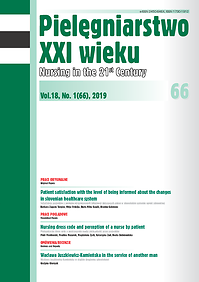Intrapartum transfers from the Birth Centre to the Obstetric Unit in 2017 – analysis of reasons
DOI:
https://doi.org/10.2478/pielxxiw-2019-0001Keywords:
Birth Centre, intrapartum transfers, place of birthAbstract
INTRAPARTUM TRANSFERS FROM THE BIRTH CENTRE TO THE OBSTETRIC UNIT IN 2017 – ANALYSIS OF REASONS
Introduction. The standard of perinatal care gives the woman the right to consciously choose the place of birth. Birth Centres (BC) run by midwives implement a vision of a non-medicalized birth in intimate homelike conditions.
Aim. The aim of the study is to determine the causes of transfers from the Birth Centre to the Obstetric Unit and to indicate the social and demographic characteristics of the women giving birth that may predispose to transfer.
Material and methods. The study was based on the analysis of the medical records of women who were transferred from the BC to the St. Sophia Obstetric Unit in Warsaw. 88 women who were transferred constituted the study group.
Results. The most numerous group were women giving birth aged 30-34. The majority were giving birth for the first time and had higher education. Intrapartum transfers were related to the mother‘s obstetric condition, fetal condition or disruption of the childbirth.
Conclusions. Failure to progress of labour is the main cause of transfers. The women giving birth for the first time aged 30 and over, admitted for to the BC after 40 weeks of pregnancy and dilation below 4 cm were the most often transferred group of women.
References
1. Wrześniewska M, Bąk B. Historia zawodu położnej i kształtowanie się opieki okołoporodowej na świecie i w Polsce. Studia Medyczne. 2012; 27(3):89-99.
2. Gierszewska M, Kwiatkowska W, Kaźmierczak M. Poród domowy – anachronizm czy wybór i potrzeba świadomych kobiet? Perinatologia, Neonatologia i Ginekologia. 2013; 6(4):220-224.
3. Dziedzic M, Matuszyk D. Prażmowska B. Poród domowy w opinii położnych. Problemy Pielęgniarstwa. 2011; 19(2):153-161.
4. Rozporządzenie Ministra Zdrowia z dnia 16 sierpnia 2018 r. w sprawie standardu organizacyjnego opieki okołoporodowej. Dz.U. 2018; poz. 1756.
5. Pankrac Z, Filipska-Kozak E, Hofman A. Realizacja praw pacjenta podczas porodu w szpitalu. Zdrowie i Dobrostan. 2015;2(1):297-308.
6. Ustawa z dnia 5 lipca 1996 r. o zawodach pielęgniarki i położnej, (Dz.U. 1996 nr 91 poz. 410).
7. Doroszewska A. Społeczne role położnych. Analiza zawodu położnej z perspektywy socjologii zawodów medycznych. Warszawa: Naczelna Izba Pielęgniarek i Położnych; 2013, s.74-78.
8. Larsen N. Birthing Center versus Hospitalized Birth. CrissCross. 2016; 4(1):1-17.
9. Overgaard C, Moller AM, Fenger-Gron M, Knudsen LB. Freestanding midwifery unit versus obstetric unit: a matched cohort study of outcomes in low-risk women. BMJ Open. 2011;1e:000262.doi:10.1136/bmjopen-2011-000262
10. Rowe R, Fitzpatrick R, Hollowell J, Kurinczuk J. Transfer of women planning birth in midwifery units: data from the Birthplace prospective cohort study. BJOG. 2012;119:1081-1090.
11. Bonadio IC, Schneck CA, Pires LG, Osava RH. Transferring mothers from a freestanding birth center to a reference hospital. Rev Esc Enferm USP. 2011; 45(6):1301-1307.
12. Barbosa da Silva FM, Schneck CA, Bick D, Osava RH. Factors associated with intrapartum transfers from a freestanding birth centre in Sao Paulo, Brazil: A case control study. Midwifery. 2012; 28:646-652.
13. David M, Berg G, Werth I, Pachaly J. Intrapartum transfer from a birth centre to a hospital- reasons, procedures and consequences. Acta Obstetricia et Gynecologica. 2006; 85:422-428.
14. Lisowska S. Ryzyko związane z ciążą po 35 roku życia. Małopolskie Pielęgniarki i Położne. 2013; 6:12-15.
15. Puszczałowska-Lizis E, Mokrzycka K, Jandziś S. Wpływ edukacji przedporodowej na przebieg ciąży, porodu i wczesne macierzyństwo. Medycyna Ogólna iNauki o Zdrowiu. 2016; 22(4):264-269.
16. Houghton G, Bedwell C, Forsey M, Lavender T. Factors influencing choice in birth place- An exploration of the views of women, their partners and professionals. Evidence Based Midwifery. 2008; 6(2):59-64.
17. Lundeen T. Intrapartum and postpartum transfers to a tertiary care hospital from out-of-hospital birth settings: a retrospective case series. J Midwifery Women’s Health. 2016; 61:242-248.
Published
Issue
Section
License
Copyright (c) 2019 Authors

This work is licensed under a Creative Commons Attribution-NonCommercial-NoDerivatives 3.0 Unported License.




